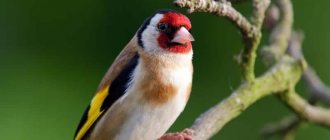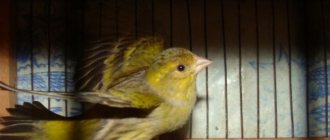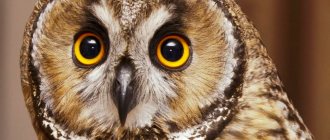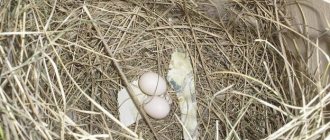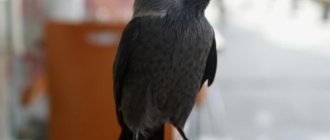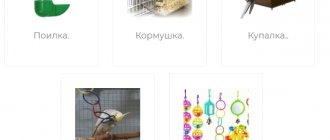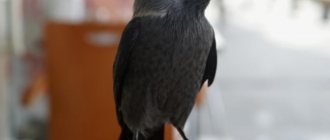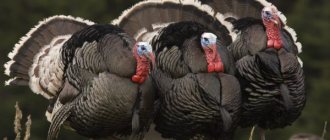A goldfinch can live at home exactly the same as in the wild. This bird is often purchased to enjoy its singing at home. This fragile and lovely creature will become your favorite if you care for it properly. How to keep such a bird at home, what to feed? Let's try to figure out all the important points together.
Goldfinch
Description and characteristics of goldfinches
Goldfinches are not frequent residents of apartments, but sometimes they can be found in people’s houses or apartments. In general, these birds are quite freedom-loving.
Goldfinches are a striking representative of the finch family; these birds are small in size and have much in common with sparrows. Most often, goldfinches live in the southern part of Scandinavia, Finland, they live in Portugal, Ireland, Western Siberia, Pakistan, Afghanistan, and some regions of Africa.
A detailed description of this bird species can be seen in the table.
| Length | About 12 centimeters. |
| Wingspan | From 22 to 25 centimeters. |
| Weight | Up to 20 grams. |
| Plumage color | The classic coloring involves a red stripe on the head - in front and black in the back, with two white stripes on the sides. The goldfinch's wings are bright yellow with black plumage. The tail is black with a white pattern. |
| Lifespan | In the wild, these birds live up to nine years, and in captivity, with good care, they can live much longer - up to twenty-seven years. |
| Does the bird sing | The goldfinch is a songbird that can sing more than twenty different melodies. Moreover, these birds are capable of making rather rude sounds. |
Table 1. Description of goldfinches
It cannot be stated unequivocally that the goldfinch is a migratory bird. Most often, these creatures do not leave their permanent habitat, even when cold weather sets in. Some species of goldfinches can fly towards warm countries. Most often, females fly away, and males remain for the winter in their place of permanent residence.
Appearance of the goldfinch
For the winter, goldfinches can go to Central Asia, to the shores of the Mediterranean Sea.
The singing of goldfinches is worthy of special attention. It is multifaceted and charming. The bird is able to convey a variety of moods with its voice, showing shades that will impress even a professional. Sometimes the bird sings very sweet songs, sometimes it amazes with simple chirping or repetition of biting, sharp sounds.
Life expectancy of goldfinches in nature and in captivity
How long do goldfinches live at home? As a rule, they live up to twenty years, provided proper care and proper feeding. In the wild, these birds rarely live longer than ten, and even more rarely, fifteen years. This is a lot for such a small bird, which can raise a couple more chicks every year.
Lifestyle and habitat
In the wild, goldfinches can be seen on the edges of forests and in copses, parks, gardens, and deciduous groves. There is no reason to clearly classify them as migratory birds. Some of the species actually try to move to areas of the planet with a warm, favorable climate by the end of summer.
But some varieties are able to withstand the cold, and therefore, closer to winter, their representatives do not prepare at all for long journeys, but simply gather in pairs, since in this way it becomes much easier for them to survive.
Only in the air do these birds feel calm and safe. This is why goldfinches spend a lot of time flying and are relatively rare on the ground.
But these winged creatures exist not only in their natural environment, but also take root well in people’s homes. Potential owners bring them from stores and markets. They end up there after falling into the snares of bird catchers.
A feathered creature as a pet is not a bad choice at all. After all, such creatures often amaze and delight people with their habits and abilities, every day giving their owners the opportunity to learn something new and interesting about themselves.
goldfinch can become a true friend and family member - a creature that can delight the eye with its wonderful plumage and the ear with melodious singing. And thanks to these qualities, the popularity of such birds among people is growing with enviable consistency.
And birds, in turn, in response to care and proper care, give their owners unforgettable moments and aesthetic pleasure.
Goldfinches have the ability to deftly stay on even thin branches
Many experts are sure that the goldfinch’s singing is no less wonderful and pleasant than that of canaries. And this is by no means a misconception. But, when keeping such a bird in your apartment for the sake of its charming singing, you should take into account that the female goldfinch , as proven by many years of observations of bird song lovers, is more sweet-sounding and sings more melodiously and tenderly.
Interruptions in the impressive performances of goldfinches are usually associated with periods when their feather cover is renewed, which is normal for any bird.
Such pets do not begin to sing in captivity immediately, but soon enough, after just a couple of months. At first, the play sounds uncertain and quiet, resembling crackling rather than singing. But as you settle into a new place, the concerts become more and more impressive, and the goldfinch’s voice sounds more and more confident.
Male goldfinches have mottled plumage, while females are grayer.
They are able to perceive the intonation of human address in the best possible way, so you should definitely talk to birds, because such domestic birds may well soon begin to take part in the dialogue.
It is not recommended to keep goldfinches in pairs; it is better to place them in different cages or at least provide separate feeders for their feathered neighbors. Otherwise, it is quite possible that the pets will not get along and will begin to arrange not only unpleasant quarrels among themselves, but also fierce fights.
But from neighboring cells they watch their relatives with pleasure, and they usually treat people with complete trust.
Is the goldfinch suitable for home keeping?
Before we look at the question of how to keep a goldfinch at home, you need to understand whether it is even possible to keep this bird at home.
Taming the goldfinch
Experts note that the goldfinch tolerates being kept at home very well, the main thing is to observe two nuances. The bird must live alone, always in an aviary or spacious cage. Only comfortable conditions and constant attention will guarantee the long life of this bird in captivity.
Let's look at the advantages and disadvantages of keeping these birds at home.
Pros:
- the brightness of the bird;
- the opportunity to listen to melodic trills all year round;
- smart and curious bird;
- sociability;
- high level of learning ability;
- unpretentiousness in food and living conditions.
Minuses:
- if you catch a goldfinch in nature, it is unlikely to sing; it is better to buy an individual in a store;
- Birds of different sexes cannot be housed in the same cage;
- Chicks should not be kept together, otherwise they will quarrel over food and home.
If the disadvantages don’t bother you, feel free to get yourself such a pet.
How to attract birds to your summer cottage
Chiffchaff in a hedge
Many beneficial birds need trees and shrubs for nesting and feeding. Ideally, your site is surrounded by a hedge of hawthorn, rosehip, elderberry, barberry and other low trees and shrubs. This barrier from unwanted guests and prying eyes will serve as a refuge for feathered helpers.
In addition, flowering trees will attract pollinating insects to the garden. If it is impossible to create a large hedge, plant several shrubs and trees on the site or behind the fence, creating an island. Leave grass under them, do not mow it, these thickets will make the green hedge a more reliable shelter for birds.
A dead apple tree or other tree surrounded by grass, thickets of ferns, meadowsweet or other hardy perennials can attract blackbirds and other birds. If the tree doesn't interfere with your plans, leave it to the birds.
Make artificial nesting boxes - birdhouses, titmouses or nest boxes, and hang them on the trees in the garden. Place them at a height of 3-8 m, be sure to calculate the optimal diameter of the entrance (3.5 cm for a tit, 5 cm for a starling).
Be sure to clean old birdhouses and prepare them for new residents; when making a birdhouse, provide a removable roof for cleaning. You can add sawdust, chopped hay or straw to the bottom. It is necessary to prepare nesting sites as early as possible, because starlings fly from warm regions in March, and tits winter in the middle zone and can begin to look closely at the home in winter.
- The right birdhouse: what should it be like?
Find out how to make birdhouses and which houses are not at all suitable for birds.
Some birds (swallows, blackbirds) need wet clay to build their nests, so they like to settle near bodies of water. If there is no natural source of water nearby, a small pond on your property will help the birds.
Pond for swallows
In autumn, leave unmown dry plants with seeds (burdock, tartar) on the site. Wintering birds will happily take advantage of this available food. You can specially grow a few sunflowers and leave the plants with baskets full of seeds for a bird feeder.
Goldfinches feed on seeds in autumn and winter
Share your harvest with the birds; you can specially plant shadberry, rowan, and hawthorn for them, and leave most of the fruits for feeding the birds. Set up winter feeders for tits with grain, pumpkin and sunflower seeds, and lard.
Viburnum fruits - food for wintering birds
Where and how to keep a goldfinch
Keeping a goldfinch in a cage
Keeping a goldfinch at home requires attention.
It is important to meet a number of conditions here:
- purchase a suitable cage;
- release the bird to fly around the house;
- feed your pet correctly;
- water the bird in a timely manner;
- create conditions for the goldfinch to reproduce.
Let's look at the important features in order.
What kind of cage is needed?
To make your bird comfortable in your home, you need to prepare a suitable cage for it. The minimum possible size of such housing should be 50 by 30 centimeters (but it is better to take a cage with a reserve, because the bird will grow, albeit slightly).
Cage and accessories for goldfinches
It is advisable that the cage have two levels. Goldfinches are very active birds and need free space to fly. At the second level, the bird can run and hide from the paws of curious pets or children.
The base of the cage should not have nicks or burrs; if it is smooth, the chances of injuring the bird will be reduced to zero.
There should be an interval of no more than one to one and a half centimeters between the bars of the cage. If the distance is greater, the bird may be injured. In addition, a cat's paw may penetrate here, or the bird will try to escape from the cage.
How to equip the cage:
- hang the feeder;
- secure the sippy cup;
- hang a swing;
- place perches at different levels (they should not have jagged edges so that the bird does not develop foot disease);
- put a small pool for bird bathing.
Bath container
Important! The cage with the goldfinch should be located away from drafts, it should be well lit, but protected from direct sunlight.
The goldfinch's cage needs to be cleaned weekly.
It should include the following activities:
- wipe the perches with disinfectants (choose those that are safe for birds);
- Wash the tray and food container with detergent;
- treat all corners, twigs, and nooks with detergent;
- rinse all parts under running cool water and dry outside for a couple of hours.
The room where the bird is located should be at normal air temperature. The main thing is to ensure that the air is not too dry or overly humidified. Therefore, the cage should be placed not near the battery and away from damp corners.
Should I let the bird fly at home?
In order for goldfinches to delight you with their singing at home, you need to create for them the most comfortable conditions, close to their wild habitat. What kind of bird can do without flying? Goldfinches also love to fly.
Flight of the goldfinch
Therefore, let your pet fly several times a day. For its convenience, prepare places where the bird can sit, rest and look around. The duration of one flight can be up to ten minutes.
While the bird is flying, remove sharp, heavy objects from surfaces so that the pet does not harm itself.
Characteristic
There are several species branches in the genus of goldfinches:
- Goldfinches: black-headed, grey-headed, thick-billed, Yemen;
- Siskins: common, small, pine, American, yellow-faced, fiery, Lawrence siskin;
- Redpolls: common, mountain, ash; Black lentils, which are similar to them, can be included in this group;
- Greenfinches: common, yellow-breasted, Chinese Ussuri.
The song of the goldfinch is full of various sounds. Its main characteristics are enthusiasm and fun. It seems that the goldfinch bird was invented precisely to lift the mood. The photo and description of this fidget leaves no one indifferent, and even more so his singing!
It is difficult to restrain yourself from using many bright epithets when describing what the goldfinch bird looks like. The photo of this handsome feathered guy is simply mesmerizing! You will recognize the bird by its bright plumage
Features of feeding goldfinches at home
What to feed the goldfinch at home? You will find the answer to this question in the table.
| What to feed the goldfinch | Ready-made mixture of grains - you can prepare it by mixing millet, burdock, dandelion and rapeseed in equal quantities. To this composition add sunflower grains, plantain, hemp. Pine and spruce seeds may not be to the taste of all goldfinches. Live food is mealworms and ant pupae; you can give the bird up to four of them per day. |
| What not to give to a bird | Sweets are strictly prohibited - they can cause digestive upset in the bird. |
Table 2. Rules for feeding goldfinches
Treats and mineral supplements
Sunflower seeds for goldfinches
To please the bird, you can treat it with a special porridge for insectivores. It can be offered up to three times a week.
Occasionally you can offer the goldfinch a salad. It is made from a hard-boiled egg, which needs to be finely chopped. Boiled grated carrots and some crushed crackers are added to it.
Nutrition
The description of goldfinches should be supplemented with a mention of the undoubted benefits that these birds bring, exterminating many pests of green spaces and valuable agricultural crops. Flocks of such birds in fields and summer cottages are frequent guests. They leave their nests, unite in flocks and go in search of food for their offspring.
The diet of adults includes mainly seeds of a wide variety of plants, ranging from trees to shrubs and herbs. A special delicacy for these birds is the seed of thistle, horse sorrel and burdocks.
They mainly prefer to feed the younger generation with larvae. In unfavorable times, when there are problems with the availability of sufficient seeds, such birds switch to other food, using small weeds, its stems and leaves for saturation.
In search of food, these active birds show remarkable agility. They actively jump through trees. In order to skillfully peck out tasty seeds, for example, from birch catkins, they are masterfully able to hover, located on thin branches.
For domestic goldfinches, ready-made food and specially prepared mixtures of grains are more suitable. They can also be fed with crushed breadcrumbs, wheat, hard-boiled eggs, dried and frozen herbs.
We should not forget about animal food. In particular, with great success you can feed such pets with mealworms, which is useful especially in winter, as well as ant pupae. The water supplied to drinking bowls should always be clean and changed regularly.
Major diseases
What causes goldfinches to die from at home? Most often this happens due to injuries, when birds fly around the apartment and crash into something sharp or drop something heavy on themselves. If the bird has injured a limb, it needs to be immobilized and consulted with a veterinarian.
Diseases of goldfinches at home:
- down feather eaters are parasites that cause feathers to thin out, they look cut, with tiny lines: you can get rid of them using special disinfectant sprays;
- knemidocoptic mange - a mite that attacks the beak or paws; the bird can be relieved of itching by using Vaseline or a special ointment;
- coccidiosis - parasites in the intestines or kidneys; for treatment, the use of vitamins and antibacterial drugs is indicated;
- pododermatitis - itchy blisters appear on the paws, which are treated with antiseptics, and the bird’s condition is alleviated with soda baths;
- neoplasms, tumors - require mandatory consultation with a veterinarian.
Veterinarian
To keep your pet healthy, you need to monitor its safety and strictly observe hygiene.
Closer to the ground
Robin
Robin , or robin, is often found in forests, especially in alder forests, gardens and parks. For nesting it chooses young spruce forests, low shrubs and even thickets of nettles. The nest is located on the ground or close to the ground in closed places - under the roots of stumps and old trees, under leaning trunks or dead wood.
The main material for building a nest is moss, dry leaves, grass. Nests with a clutch of eggs can be found as early as late April – early May.
The robin feeds on small caterpillars and beetles, collects aphids, slugs and other leaf beetles on the leaves, and finds millipedes under fallen leaves. At the end of summer it feeds on berries - blueberries, bird cherry, buckthorn, euonymus.
The white wagtail is widespread throughout the country; it prefers to nest near bodies of water - in floodplains of rivers, along the banks of ponds. A wagtail's nest can be found in a wide variety of places - in natural depressions in the soil, under tree roots and under bridges, under the bark of a decrepit tree, under the eaves of a house or in a crack in a stone fence.
White wagtail
The building material and shape of the nest depends on the location; most often it is a loosely woven shallow bowl. Birds use dry grass and leaves, wood fibers, straw, and feathers. In spring, the wagtail appears in the middle zone as one of the first birds; a clutch of eggs can be found at the end of April; in favorable years there may be two broods per season.
The wagtail feeds on a variety of crawling and flying insects, which it catches mainly on the ground, on roads, on the roofs of buildings and in vegetable gardens.
Reproduction of goldfinches at home
Breeding goldfinches at home is possible. In the wild, these birds begin nesting by the end of spring, if they live at home - this process can go on all year round.
Conditions for nesting
In order for a bird to want to lay eggs, it is necessary to place natural material in the cage from which it can make a nest. These can be pieces of tree bark, lichen, meadow grass, wool. From this material, the female will almost immediately begin to build a nest in which she will lay eggs.
Pair of goldfinches
Laying and incubating eggs
When the nest for the goldfinch living at home is ready, a male is released into the female’s cage.
When the mating season has passed, the male can be returned to his cage. The female will incubate the eggs for two weeks.
Caring for chicks and feeding them
After the chicks hatch from the eggs, they are kept with the female for 16-20 days, then they need to be moved to a separate home.
You can feed the chicks with insects and special grain mixtures.
Social structure and reproduction
Photo: Pair of goldfinches
Peculiarities of reproduction, duration of the mating season and other aspects associated with offspring depend on the varieties of goldfinches and the place where they permanently live. In their natural environment, goldfinches begin to breed and look for a mate at the end of February. In areas with a warm climate, the mating season may begin earlier. These birds quickly break into pairs and immediately begin building their family nest.
The process of building a nest in goldfinches has some features:
- the entire process is handled exclusively by the female;
- the shape of the goldfinches' houses resembles thick bowls;
- The nest must be located on tall trees, away from the trunk. In this way, the animal tries to protect future offspring from predators;
- the nest is built from blades of grass, moss, lichen, bast fibers, and roots.
In May, usually all the goldfinches are already divided into pairs and have their own nest. Next, the main role is assigned to the male. He must impregnate the female. Females lay eggs closer to summer. There are about six eggs in one clutch. The eggs have a greenish or bluish tint to the shell. The female has to hatch them for about two weeks, after which the chicks are born.
The young animals are completely under parental care for another two weeks. Then they are completely ready for independent life, so they quickly leave the house. However, at first, the young prefer to stay close to the parent’s nest, because for some time the parents feed their children with insects and larvae.
Features of taming goldfinches
The goldfinch is a domestic bird, easily tamed. In order for your pet to get used to you faster, it is important to spend time next to him more often. The bird needs to see who is putting food on the feeder for it when it begins to trust you faster.
Goldfinch chick
Over time, when the chick gets used to it, you can start teaching it to feed by hand.
Goldfinch bird: appearance
With a body length of just over 19 cm, the goldfinch weighs only 20 grams, sometimes more. The wingspan of this baby is quite large - up to 25 cm. Although it is small, its body is dense and compact. Goldfinches boast the thickest and densest feather cover of all passerines.
The goldfinch has a short neck. The beak is not very long, sharp at the end. The goldfinch is a multicolored bird. It can be easily recognized by the color of its head. It can be jet black, white or bright red. The predominant colors of the body plumage are café au lait, blue, yellow, and purple.
Where can I buy goldfinch
You can buy goldfinches second-hand or contact experienced bird catchers or a pet store. The second option is preferable because such a purchase has almost no risks. You will definitely get a healthy bird that will have minimal communication skills and proximity to humans. If you buy a bird from your own hands, you cannot guarantee that it will easily get used to your home and will not be infected with parasites (some of them can be dangerous to people).
Goldfinches can be purchased in pairs, or one bird can be purchased. The main thing is to house the birds separately, in different cages. Otherwise, the pets will quarrel and be aggressive towards each other.
Acquiring a goldfinch
Hollows and artificial dwellings
Great Spotted Woodpecker
The Great Spotted Woodpecker lives in tall mixed and pine forests, small groves, gardens and parks. It nests in hollows of dry or living trees, preferring species with soft wood. The hollow is most often located at a height of 2 to 5 m from the ground. The inside of the nest is lined with small pieces of wood. The woodpecker lays eggs in late April - early May.
It is not for nothing that the woodpecker is called the forest orderly; this useful bird in spring and summer rids trees of numerous pests - bark beetles, chafers, bedbugs, ants, and in winter it switches to seeds of coniferous trees, hazel, and acorns.
The common starling lives in open forests, gardens and parks. It nests near human dwellings and occupies artificial nesting sites - birdhouses, niches under roofs and balconies, as well as hollows left by different species of woodpeckers. Birds prefer to settle in colonies, with several pairs nearby. The nest is lined with soft grass, straw, and bird feathers. Starlings arrive in the middle zone very early; eggs appear in the nests in April; in the southern regions there are two broods per season.
Common Starling
The benefits of birds are undoubted; starlings destroy caterpillars of insect pests, slugs, chafers and their larvae in gardens and orchards, in potato fields; they eat flies, gadflies, horseflies and their larvae in pastures; in the southern regions they catch various locusts. At the same time, starlings can damage the harvest of gardens and vineyards, but while eating berries, they also collect harmful insects.
The great tit settles near humans more often than other birds, lives in parks, gardens, sparse deciduous forests, and avoids dense coniferous forests. The nest is made in closed places - hollows, nests of squirrels or birds of prey, in birdhouses or artificial nests (dugout houses), in crevices of buildings. The building materials are moss, thin plant fibers and twigs, wool, fluff, and cobwebs. Nesting in the middle zone begins in the second half of May.
Great tit
The tit feeds on insects and spiders, their eggs, and caterpillars, which it finds on tree trunks. In autumn and winter, birds switch to plant foods, eat seeds of various herbs and trees (burdock, quinoa, sunflower, spruce, pine), remove seeds from berries, and can eat food waste near their homes. In harsh winter, when there is a lack of food, they happily fly to feeders in gardens and parks.
Possible problems when keeping goldfinches at home
To ensure that goldfinches are kept without problems, pay attention to the useful recommendations of professionals.
Helpful Tips:
- To prevent the bird from getting sick, maintain hygiene and the rules of keeping it;
- place the cage only away from drafts and direct sunlight, but not in the dark or near places with excess moisture;
- The goldfinch is unlikely to like it near the radiator; it is better to choose a place away from heating devices;
- the goldfinch should eat twice a day; if the bird is weakened or sick, it can be fed more often;
- in winter, birds need to be given special supplements with valuable components to maintain immunity strength and health;
- the cage should always have a full sippy cup with clean water, which needs to be changed regularly;
- you need to wash the cage with products without strong odors; after general cleaning, it is better to ventilate the bird house for a couple of hours in the fresh air;
- in order for the bird to maintain its cleanliness, you need to put a special container in the cage where it can bathe;
- If any disturbing symptoms appear in the bird, such as refusal to eat or sleepiness, the pet should be shown to a veterinarian.
Singing Goldfinch
Today, in many large cities, it is not a problem to find an experienced ornithologist who will help you figure out how to keep the bird healthy and happy.
Where do goldfinches like to live and what do they eat?
It’s easier to say where goldfinches prefer not to live – these are dense forests with dense thickets. Goldfinches of all types adore sparse forests, open places with groves, floodplains and river valleys, city parks (if the plantings in them are not too frequent).
The basis of nutrition for goldfinches of all types is seeds. Most species prefer weed seeds. They love burdock, thistle, and burdock very much. Some people do not refuse seeds of cultivated plants. They enjoy plucking fresh greens in the spring. It happens that they eat insects, but extremely rarely.
In places where there are no weeds at all, goldfinches practically do not live.
Reviews from owners about keeping goldfinches at home
Goldfinches owners leave the following reviews about their pets:
- keeping poultry requires financial costs;
- With the appearance of this pet, I had to clean the apartment more often;
- the bird sings pleasantly, but sometimes begins to do so right at dawn;
- If you catch a bird with both hands, it can pretend to be dead - a very interesting trick.
A goldfinch at home is always joy, hubbub and pleasant singing. To make your bird please you every day, pay attention to its arrangement, create suitable conditions for it, and select the right food.
Bird walking
It is vitally important for the bird to be allowed to fly, and the point here is not even that it is boring when locked up, but mostly in nutrition.
Since goldfinches eat a lot of fat, they are susceptible to obesity, and this problem can be avoided using two comprehensive methods: give more greens, vegetables and fruits, and be sure to walk the bird. The goldfinch in the photographs in this article is not locked up at all, but comes to spend the night in the cage on its own, voluntarily, except in cases of hooliganism.
In an apartment, goldfinches, unlike robins, prefer to fly and sit higher: on tables, cabinets, and chandeliers. This is explained by the fact that in nature they prefer to live higher in the tree. If you have a large mirror in the room where the goldfinch lives, then most likely he will hang around it. And the garbage will be where the goldfinch will spin.
It is naive to think that it is enough to lay down a newspaper and shake off the garbage from it. In this case, the newspaper will become the main source of garbage. Our goldfinch’s favorite pastime is gnawing, tearing and littering; he devotes all his time to this activity during the “walk.”
Pairing
In the spring, in April, the time comes for the birds to breed, so they are put in a common spacious cage. Its recommended size is at least 80 cm in length. The floor is covered with thin twigs, plant stems, small leaves, grass, moss - from these the birds will build a nest, the base for which is installed closer to the edge of the cage.
If the canary and the goldfinch do not like each other, they will quarrel. It will no longer be possible to obtain offspring from these birds, so the canary will have to be replaced.
Behavior of the goldfinch during the nesting period
If a pair is formed from a wild male goldfinch and a domesticated female canary, you should observe the behavior of the gentleman. Usually the goldfinch treats the canary kindly, helps it build a nest, hatches its eggs, and feeds it. A sign that a couple has been created is that the male “bows” to the female with his tail spread out and periodically flaps his wings.
However, this also happens: the wild goldfinch begins to behave aggressively. In this state, it is capable of destroying the nest and clutch. For this reason, experienced breeders, if possible, replace the eggs laid by the female participating in hybridization with ordinary ones - they are taken from a pair of canary and canary. Hybrid ones are placed on an experienced canary hen or placed in an incubator. This way there is a better chance of waiting for the chicks.
